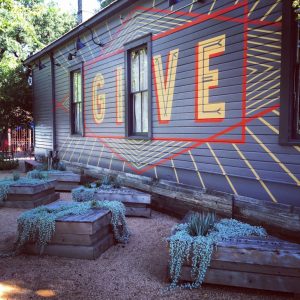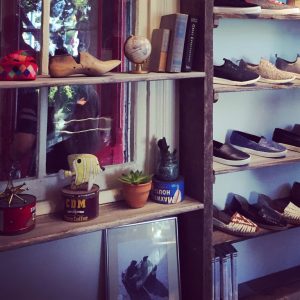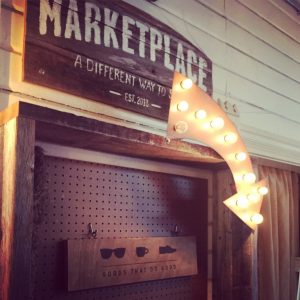With “generous brands” on my mind after the closing keynote at the 2015 International Retail Design Conference (IRDC) and retail storytelling in my veins, I set out on the streets of Austin, Texas, in search of the Tom’s store. A block away from the iconic “I love you so much” sign, the Tom’s store is perched on a hill overlooking a corner of Austin’s hip South Congress Street. It’s here that Tom’s second brick-and-mortar store (or in this case, a reclaimed Victorian house) creates a culture of its own.
Photography: Rebekah L. Matheny, Columbus, Ohio
Many of us know about Tom’s “One for One” campaign – I’ve personally been in love with my Tom’s wedges for years and buy a new pair each season (it’s a way for my guilty obsession with shoes to also “do good”). And some of us may also know that when you buy Tom’s eyewear, you help the company bring glasses and medical eye treatment to more than 325,000 people worldwide.
But were you aware that 2 million children have been given shoes and medication to date to protect them from hookworm? Or that because these children have been given shoes, they can now walk to school giving them hope for a more educated future? Or that as a result of shoe-giving, there has been an increase of 42 percent in healthcare participation by mothers? Yes, Tom’s programs provides shoes, glasses and clean water, but it’s more than just giving; The impact of this gesture is far-reaching, and the influence of a single purchase can make a life-changing impact.
Going beyond giving, this generous brand creates jobs around the world with a social and environmentally sustainable mission. And through their giving trips, they aren’t afraid to put boots on the ground either! (To learn more about Tom’s giving programs and how they invest in people and communities, spend some time reading their story on the Tom’s website.)
From its website to its retail stores, transparent storytelling is ingrained in Tom’s DNA. And although they’re a retailer selling shoes, sunglasses and coffee, it’s more than that: It goes beyond a retail space and becomes a memorable place that creates a cultural experience bringing people together who share a similar philosophy. Can this progressive retail thinking be the catalyst for future social change?
Advertisement
Photography: Rebekah L. Matheny, Columbus, Ohio
“[The store is a] real space for the community,” said Tom’s founder Blake Mycoski to Culture Map Austin, referring to its Austin, Texas, location. “I don't like to call it a store. It's more of a community meeting place for people who are inspired by what we are doing, and [are] doing other great things themselves.”
And he couldn’t be more right. The entire Austin, Texas, store journey guides the customer, or more aptly, the community activist, through the authentic and inspiring Tom’s experience. This aspirational community store conveys Tom’s brand mission throughout the entire experience.
The moment you approach the painted Victorian home which proudly states “GIVE” on it’s façade and take note of the vintage sign stating “live for today, give for tomorrow,” from the picnic tables and porch swing to the brightly painted lawn furniture, you truly know that this is not just a store, but a facilitator of meaningful human connections.
Photography: Rebekah L. Matheny, Columbus, Ohio
Every graphic element in the store illustrates the meaning of Tom’s story. In addition to a simple iconographic of a pair of glasses equaling an eye, this bold statement – which you can’t turn the corner without reading – rings true about the brand: “We’re in the business to help improve lives.”
Advertisement
Both old and new artifacts from around the globe fill the reclaimed wood shelves and pushes the brand’s impact to the forefront of the shopping experience. Along with these relics, books and real plants, such as native succulent and cactus, are integrated into each merchandise display.
Photography: Rebekah L. Matheny, Columbus, Ohio
Adorning the walls and ceilings as decorative textures, global tribal motifs are used to create a connection between the shoes’ fabric patterns and the people making these textiles. Continuing this notion of creating connections, the community board puts a face to the brand, showcasing volunteers during their trips.
Taking a unique approach to the layout, only half the space is dedicated to product display; the other half centers around the community. In its back café area, which feels more like a sunroom in a mid-century home, with it’s geometric wood-framed glazing and retro-style freestanding cone fireplace, the space features a relaxed ambience where people come to hang out..
Photography: Rebekah L. Matheny, Columbus, Ohio
On one wall, alongside a tribal tapestry, a world map illustrates the brands outreach, having “changed lives” in 70 different countries. With this concept of outreach, the community store experience blurs the line between indoor and outdoor space.
Advertisement
The smell of coffee emits from the front door, and the outdoor patio spaces allow visitors to casually gather, not only connecting people within these spaces, but also communicating Tom’s message to the larger Austin population.
Photography: Rebekah L. Matheny, Columbus, Ohio
It’s in these moments within a store’s design that truly matter and make all the difference. It’s where the story becomes real and where meaningful human connections happen. All too often, in today’s digitally immersive world, we forget to design opportunities for human connections to occur.
Like the Tom’s store, how can we unite people with a common goal? How can we design a retail journey around a meaningful story? If we think of our stores not simply as a place to sell products, but rather, as a meaningful place to gather people, how would that change our design process and our consumer behaviors?
Rebekah L. Matheny is the assistant professor of interior design at The Ohio State University (Columbus, Ohio), where she teaches courses in interior finish materials, lighting design and design studios that integrate a retail brand strategy process. Matheny’s research investigates the sensory perception of interior finish materials and their application in retail design to create an emotional connection between the customer and the brand. Follow Rebekah and her journey with materials on Instagram @rebekahmathenydesign and to start a dialogue about the sensory experience of materials visit her web site interiormaterialsmatter.com.


 Photo Gallery2 days ago
Photo Gallery2 days ago
 Headlines1 week ago
Headlines1 week ago
 Headlines2 weeks ago
Headlines2 weeks ago
 Sector Spotlight2 weeks ago
Sector Spotlight2 weeks ago
 Headlines1 week ago
Headlines1 week ago
 Headlines4 days ago
Headlines4 days ago
 Headlines2 weeks ago
Headlines2 weeks ago
 Designer Dozen1 week ago
Designer Dozen1 week ago





































